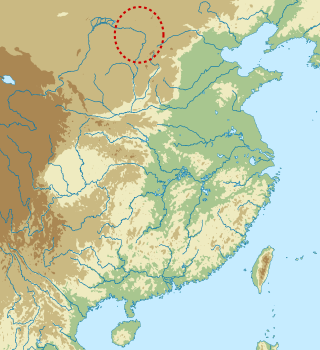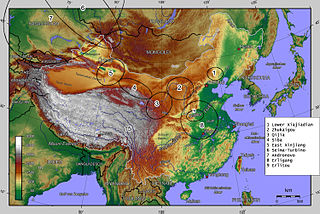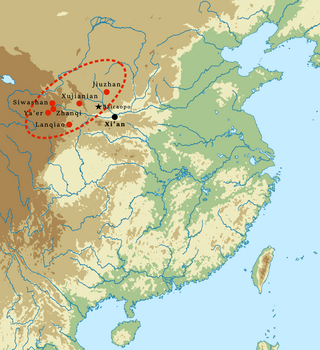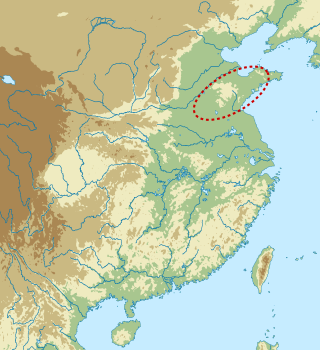西團山 (Chinese) | |
| Alternative name | Seodansan |
|---|---|
| Location | Jilin Province |
| Region | Huanxi Township, Chuanying District |
| Coordinates | 43°48′12″N126°29′51″E / 43.803352°N 126.497415°E |
| Altitude | 196 m (643 ft) |
| Type | Burials |
| Area | 80,000 km2 |
| History | |
| Periods | Bronze Age 9th-6th centuries BCE. [1] |
| Cultures | Xituanshan |
| Site notes | |
| Discovered | 1930s |
| Excavation dates | 1948, 1949, 1950 |
- 1 2 Barnes, Gina L. (2017). "Book review of The Ancient State of Puyŏ in Northeast Asia: Archaeology and Historical Memory" (PDF). Journal of Chinese Studies. 65: 356.
- ↑ Zhai 2013.
- 1 2 3 Dong 2009, p. 28.
- 1 2 Zhai 2013, p. 200.
- 1 2 3 Dong 2009, p. 31.
- 1 2 Dong 2009, p. 29.
- ↑ Dong 2009, p. 34.
- 1 2 3 Dong 2009, p. 30.
- ↑ Dong 2009, p. 30-31.
- ↑ Dong 2009, p. 32.
Related Research Articles
Sushen is the modern Chinese name for an ancient ethnic group of people who lived in the northeastern part of China and what is in modern times the Russian Maritime Province and some other Siberian provinces. They were active during the Zhou Dynasty period. Archeological relics in the area are attributed to the Xituanshan Culture. Chinese Bronze Age archaeologist Zou Heng of Peking University believed that the Sushen were also related to the Lower Xiajiadian culture. The Sushen are thought to have been Tungusic speakers.

The Longshanculture, also sometimes referred to as the Black Pottery Culture, was a late Neolithic culture in the middle and lower Yellow River valley areas of northern China from about 3000 to 1900 BC. The first archaeological find of this culture took place at the Chengziya Archaeological Site in 1928, with the first excavations in 1930 and 1931. The culture is named after the nearby modern town of Longshan in Zhangqiu, Shandong. The culture was noted for its highly polished black pottery. The population expanded dramatically during the 3rd millennium BC, with many settlements having rammed earth walls. It decreased in most areas around 2000 BC until the central area evolved into the Bronze Age Erlitou culture. The Longshan culture has been linked to the early Sinitic . According to the area and cultural type, the Longshan culture can be divided into two types: Shandong Longshan and Henan Longshan. Among them, Shandong Longshan Cultural Site includes Chengziya Site; Henan Longshan Cultural Site includes Dengfeng Wangchenggang Site in Wangwan, Taosi Site and Mengzhuang Site in Hougang.
The Hongshan culture was a Neolithic culture in the West Liao river basin in northeast China. Hongshan sites have been found in an area stretching from Inner Mongolia to Liaoning, and dated from about 4700 to 2900 BC.
The Wucheng culture (吳城文化) was a Bronze Age archaeological culture in Jiangxi, China. The initial site, spread out over 4 km2 (1.5 sq mi), was discovered at Wucheng Township, Jiangxi. Located on the Gan River, the site was first excavated in 1973. The Wucheng culture probably developed in response to cultural contacts with the expanding Erligang culture, melding Erligang influences with local traditions. The Wucheng culture was a distinct contemporary of Sanxingdui and Yinxu (Anyang).

The Zhukaigou culture was a late Neolithic and early Bronze Age culture centered in the Ordos Plateau of Inner Mongolia, China. The type site at Zhukaigou was discovered in Ejin Horo Banner, Inner Mongolia, and excavated from 1977 to 1984. Zhukaigou culture is a reputed progenitor of the Ordos bronze culture and accordingly a first "Northern Zone" culture, extending to northern and central Inner Mongolia, northern Shaanxi, and northern Shanxi, with the Ordos region at its center. Transition to metalworking is dated to around the end of the third millennium BCE, at the same time was attained a higher level in the ceramic. Zhukaigou culture lasted to c. 1500 BCE.

The Lower Xiajiadian culture is an archaeological culture in Northeast China, found mainly in southeastern Inner Mongolia, northern Hebei, and western Liaoning, China. Subsistence was based on millet farming supplemented with animal husbandry and hunting. Archaeological sites have yielded the remains of pigs, dogs, sheep, and cattle. The culture built permanent settlements and achieved relatively high population densities. The population levels reached by the Lower Xiajiadian culture in the Chifeng region would not be matched until the Liao Dynasty. The culture was preceded by the Hongshan culture, through the transitional Xiaoheyan culture. The type site is represented by the lower layer at Xiajiadian in Chifeng, Inner Mongolia.

The Ordos culture was a material culture occupying a region centered on the Ordos Loop during the Bronze and early Iron Age from the 6th to 2nd centuries BCE. The Ordos culture is known for significant finds of Scythian art and may represent the easternmost extension of Indo-European Eurasian nomads, such as the Saka, or may be linkable to Palaeo-Siberians or Yeniseians. Under the Qin and Han dynasties, the area came under the control of contemporaneous Chinese states.

The Xiliao or West Liao River is a river in Inner Mongolia and Liaoning province, in northeast China. Its source is the Xilamulun River in Inner Mongolia. It is one of the headwaters of the Liao River.
Xihoudu is an archeological site located in the Shanxi Province of China. The site dates to the Paleolithic Age. In total 32 stone implements were found at the site.

Kayue culture was a Bronze Age culture in Northwest China in the area of the upper reaches of the Yellow River and its tributary Huang Shui. It was discovered in 1923 in the villages Kayue (卡约) and Xiaxihe (下西河) of Yunguchuan Huangzhong in China's Qinghai Province and is named after the village of Kayue. The former name of the Kayue culture was Kayao culture, it was previously assigned to the Siwa culture. It is dated to the period of approximately 900 to 600 BCE.

The Siwa culture was a Bronze Age culture in southeast Gansu Province, China. It was discovered by Swedish geologist Johan Gunnar Andersson in 1924 at Mount Siwa (寺洼山) in Lintao County, hence its name. It flourished circa 14th to 11th century BC, it is tentatively attributed to the cultures of the Northern Di, Qiang, and Xunyu peoples.
Baijinbao is an archaeological site of the Baijinbao culture, a Bronze Age culture in China's northeastern province of Heilongjiang, dated by about 900 BC, the time of the Western Zhou period. The site is located in the village Baijinbao on the left bank of the Nen Jiang 嫩江 river near a town Minyi of the Zhaoyuan county in the Songnen Plain.

The Yueshi culture was an archaeological culture in the Shandong region of eastern China, dated from 1900 to 1500 BC. It spanned the period from the Late Neolithic to the early Bronze Age. In the Shandong area, it followed the Longshan culture period and was later replaced by the Erligang culture.

The Liao Civilization or Liao River Civilization, named after the Liao River, is an ancient civilization that originated in the Liao basin. It is thought to have formed in about 6,200 BC. This civilization was discovered when Ryuzo Torii, a Japanese archaeologist, discovered the Hongshan culture in 1908.
Fanchengdui culture is an archaeological culture discovered in 1970, in the town of Zhuwei, Qingjiang county, Jiangxi province, China, in archaeological sites such as Fanchengdui. It is a distinctive type of Chalcolithic to Bronze Age culture.

'En Esur, also En Esur or Ein Asawir, is an ancient site located on the northern Sharon Plain, at the entrance of the Wadi Ara pass leading from the Coastal Plain further inland. The site includes an archaeological mound (tell), called Tel Esur or Tell el-Asawir, another unnamed mound, and two springs, one of which gives the site its name.

The Hashihaka kofun is a megalithic tomb (kofun) located in Sakurai, Nara Prefecture, Japan. The Hashihaka kofun is considered to be the first large keyhole-shaped kofun constructed in Japan and is associated with the emergence of the Yamato Kingship.
Fushan archaeological site is located in Fushan Village, Beinan Township, Taitung County, Taiwan. The site dates from around 3,700 or 3,800 years ago to roughly 3,000 years ago, which belongs to the middle Neolithic Period. Fushan Culture is named after the site. In 1997, the site was divided into Fushan First Site in the south and Fushan Second Site in the north when conducting the “General Investigation and Research Project of Archaeological Sites in Taiwan.”

Majiayuan (Ch:马家垸遗址) is an 3rd-2nd century BCE archaeological site in Gansu, China. The site is considered as belonging to rulers of the culture of the Xirong, recently subjugated by the state of Qin, who included them within the defensive wall of King Zhao of Qin, built in 271 BCE. It is rather similar to another Xirong site about 50 km away, the Wangjiawa cemetery (王家洼墓地). Majiayuan was a zone of interraction between the Chinese and their nomadic neighbours to the west and north during the Warring States period.
The Tianshanbeilu culture, also named Linya, Yalinban or Yamansukuang, is an ancient Bronze Age age culture centered around the Tianshanbeilu cemetery in the region of Hami. The Tianshanbeilu culture played an important role in connecting the Hexi Corridor with the Tianshan Corridor. The cemetery remained in use until 1093–707 cal BCE. Tianshanbeilu is the largest Bronze Age site in eastern Xinjiang.
References
- Dong, Xuezeng 董学增 (2009), "吉林西团山文化六十年研究成果概述" [An overview of achievements in the last 60 years of research on Jilin's Xituanshan culture], Bowuguan Yanjiu (in Chinese), 1 (105): 28–37, doi:10.13368/j.cnki.mure.2009.01.008
- Zhai, Jingyuan 翟敬源 (2013), "吉林西团山文化概述及其文化价值" [Overview of Jilin's Xituanshan culture and its cultural value], Heilongjiang Keiji Xinxi (in Chinese) (9): 200
External links
| Xituanshan | |||||||
|---|---|---|---|---|---|---|---|
| Chinese name | |||||||
| Traditional Chinese | 西團山 | ||||||
| Simplified Chinese | 西团山 | ||||||
| |||||||
Prehistoric cultures of China | |
|---|---|
| Northeastern China | |
| Upper Yellow River | |
| Middle Yellow River | |
| Lower Yellow River | |
| Middle and Upper Yangtze | |
| Lower Yangtze and Huai | |
| Southern China | |
| Tibet | |
| Xinjiang | |
| Taiwan | |
| Other | |
